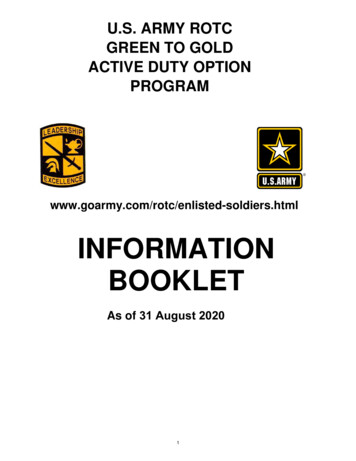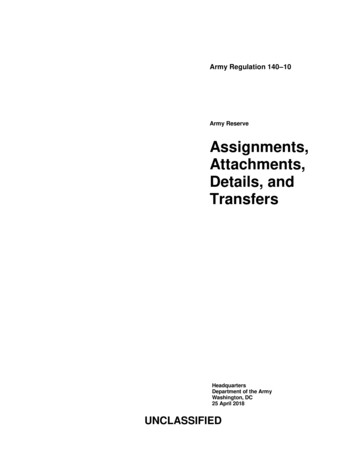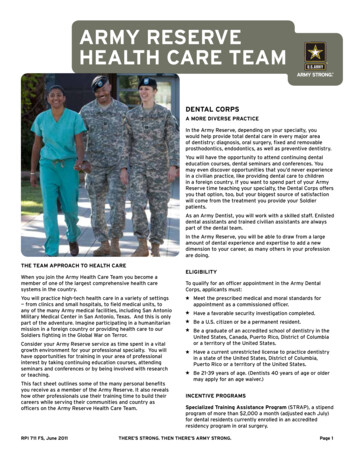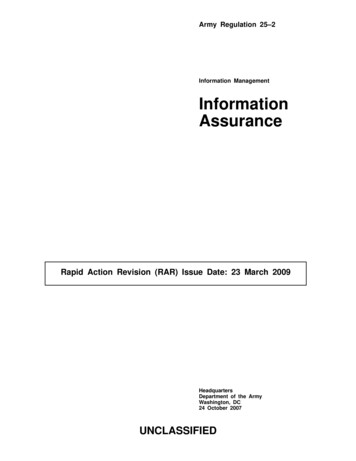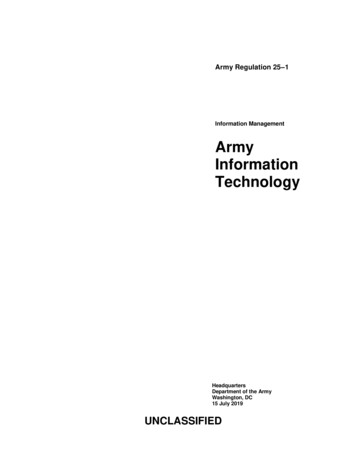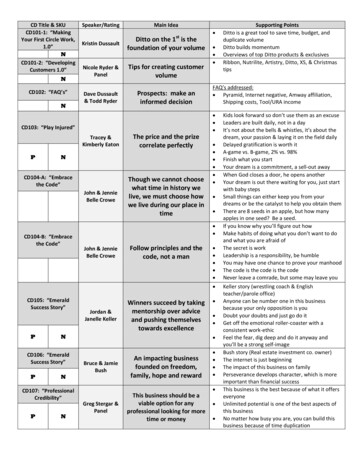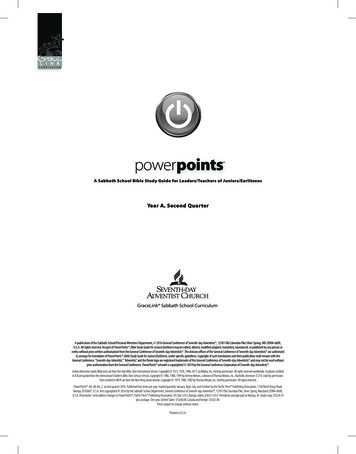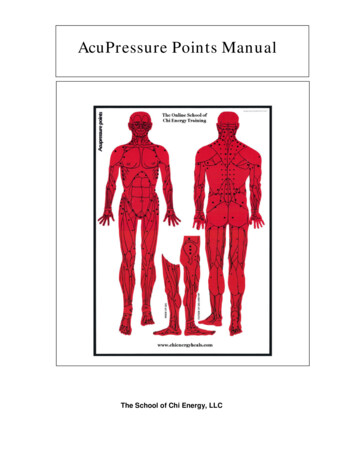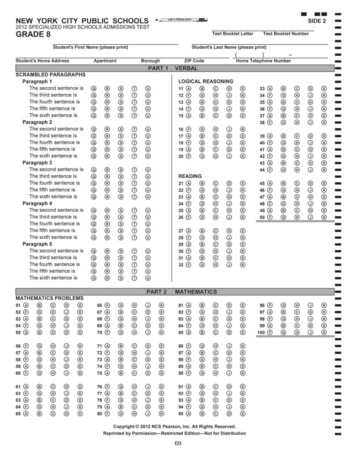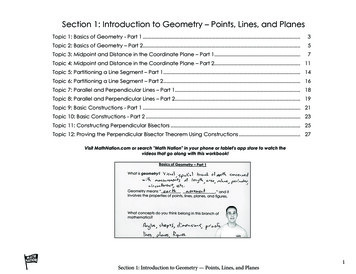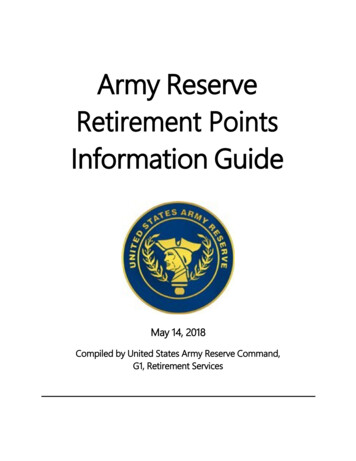
Transcription
Army ReserveRetirement PointsInformation GuideMay 14, 2018Compiled by United States Army Reserve Command,G1, Retirement Services
Contents (Listed by paragraph number)Chapter 1 GeneralOverview 1-1, page 3Retirement Points History1-2, page 3Qualifying Years of Satisfactory Service 1-3, page 3Anniversary Year End (AYE) Date 1-4, page 4Establishment and Adjustment to AYE 1-5, page 4Exceptions to Calculating AYE dates 1-6, page 4Credit for Partial Years of Service 1-7, page 4Eligibility for Retirement Point Credit for Non-Regular Retirement 1-8, page 5Retirement Point Credit by Activity1-9, page 5Reporting Points to Retirement Point Accounting System (RPAS) 1-10, page 6Chapter 2 Manual InputManually Update Retirement Points 2-1, page 6To Update Retirement Points manually 2-2, page 6A VOID or BLANK DA Form 5016 2-3, page 7Maintain Retirement Points Business Rules 4-4, page 7Chapter 3 Nonresident CoursesArmy Correspondence Courses 3-1, page 8Electronic Based Distributed Learning 3-2, page 9Chapter 4 Points for Non-Paid TrainingRetirement Points Non-Paid Training DA Form 1380 (Record of Individual Performanceof Reserve Duty Training) 4-1, page 9Common errors with the DA Forms 1380 4-2, pages 10 & 11Chapter 5 tion 5-1, page 12AppendixesA-1. References, page 13B-1. Supporting Documents, page 14B-2. Army Human Resources Command Personnel Action Branches Point of Contactspage, 15B-3. Other Services POCs for Retirement Points, page 16C-1. Reporting Points to RPAS, page 172
Chapter 1General1-1 OverviewThis information guide provides an overview and standard operating procedures for theReserve Component Retirement Points Accounting System (RPAS); when, where, and howHuman Resources (HR) Professionals to contact Army Human Resources Command (AHRC)for assistance and input; when, where, and how to review Soldier retirement point records;business rules on cases unit HR personnel should complete and those that require assistancefrom AHRC; documentation required and how to acquire it to support retirement pointstransactions and corrections.The information guide also includes information on crediting and awarding of retirementpoints, establishment of the Anniversary Year End (AYE) date, proof of performancedocuments, eligibility for retirement points, and retirement points for non-paid training.Unit HR personnel with challenging cases should contact their Regional Personnel ActionCenter (RPAC), US Army Reserve Command G-1, Service and Support Division or ArmyHuman Resources Command (AHRC), Personnel Action Branch (PAB). Additionalinformation and guidance pertaining to retirement points is available on the Army ReserveCommand G-1 website at https://arg1web.usar.army.mil/ and the AHRC web site nts%20Accounting%20System%20RPAS.1-2 Retirement Points Historya. When awarding retirement points a member is only entitled to a defined maximum ofIndividual Duty Training (IDT), Extension Course and Membership points per year.However, RPAS will allow entrance of more points and display them but it will not count inthe total points. Retirement points credited for activities other than active service or FuneralHonors as defined as IDT and Membership points may not exceed:(1)(2)(3)(4)Prior to 23 Sep 1996: 60 point rule in effectOn or after 23 Sep 1996: 75 point rule in effectOn or after 30 Oct 2000: 90 point rule in effectOn or after 30 Oct 2007: 130 point rule in effectb. All active duty training is credited. However, a Soldier can only receive credit for amaximum of 365 (366 in a leap year) retirement points in a year.1-3 Qualifying Years of Satisfactory ServiceA qualifying year of service for non-regular retired pay is when the Regular or Reserve Soldieris credited with a minimum of 50 retirement points.3
1-4 Anniversary Year End (AYE) DateAYE date determines the last day a retirement point may be updated annually for a Soldier, so itis important to understand how it is established. The AYE date can only be changed byAHRC.1-5 Establishment and Adjustment to AYEThe date to determine the AYE date is established by the date the Soldier entered into activeservice or into active status in a Reserve component. The date the Soldier enter the ActiveReserve is their anniversary year beginning date. As long as the Soldier has no break-in-service,the Anniversary Year Ending date (AYE) will be one year later.a. For example, a Soldier who joins the Army Reserves on 2 July would have ananniversary year beginning date of 2 July and an AYE of 1 July, one year later minus 1 day.b. A break-in-service occurs only when a Soldier transfers to an inactive status list, theinactive National Guard, a temporary disability retired list, the Retired Reserve or is dischargedto civilian life for longer than 24 hours. There will be no break-in-service if the Soldiertransfers directly to another Regular or Reserve Component. When a Soldier with a break-inservice returns to an active Reserve status or to active service, the revised AYE start date shallbe the date of return or reentry.1-6 Exceptions to Calculating AYE datesa. In the case of Officers with Reserve service as a cadet or midshipmen at Service or in aReserve Officers’ Training Corps program, the AYE start date is established by the date theSoldier entered into active service or active status, minus any service as a cadet or midshipman.b. In the case of enlisted Soldier (who served as a cadet or midshipman but who did notlater receive or who do not hold a commission as an officer), service as a cadet ormidshipman at a service academy shall be included and counted as active duty. You shouldbe able to find this information on the individual’s contract.1-7 Credit for Partial Years of Servicea. A Soldier who has a break-in-service that occurs during an AYE shall be credited with apartial year of qualifying service for non-regular retirement. When, as a result of a break-inservice, a partial year occurs, the Soldier must meet the minimum retirement pointrequirements for the Soldier’s service to be credited as a partial year towards a qualifying year.A partial qualifying year is any period less than 12 full months in which the retirement pointscredited to a Soldier, when computed proportionally, are equal to or greater than 50 points.Calculation of credit for a partial year shall be made according the Soldier’s IDT points for thatyear per DODI 1215.07. Partial years of qualifying service may be combined and creditedtowards total qualifying service.b. Membership points for any partial year shall be credited based upon DODI 1215.07. Oncompletion of a partial year, points for attendance at drills or equivalent instruction, proratedmembership points, and points credited as a result of satisfactory participation in the DoDHealth Professions Scholarship and Financial Assistance Program or other service creditablefor non-regular retired pay purposes shall be credited. Such points credited for a partial yearmay not exceed rules in paragraph 1-2. The Retirement Point Accounting system (RPAS)figures membership points on partial years. Contact AHRC Personnel Action Branch atAppendix B-3 of the Soldier and complete as a manual retirement point case if necessary.4
1-8 Eligibility for Retirement Point Credit for Non-Regular Retirementa. Soldiers in the following categories are eligible for retirement point credit:(1) Soldiers of a Regular or Reserve component in active service.(2) Soldiers of a Reserve component in an active status as defined in 10 USC 10141.This includes service in a Delayed Entry Program established by 10 USC 513. This service iscredited toward non-regular retirement since it is service in an active status as a Soldier of theReady Reserve.(3) Soldiers who have retired from active service, or members transferred to the RetiredReserve under the conditions described in 10 USC 12741, who are ordered to perform activeduty, may be credited with active or inactive duty service (Retiree Recall).b. Soldiers in the following categories are not eligible for retirement point credit:(1) Members of a Reserve component in a retired status.(2) Members of a Reserve component in an inactive status (to include TDRL, InactiveStandby, Inactive NG, Incapacitation. Pay, Inactive status of any service, AWOL) under 10USC 12734(a). Individuals who have completed the service requirement for retired pay andare not 60 years old may be transferred to an inactive status, but may not receive retirementpoint credit in that status.c. See the table below for responsibilities for organizing, maintaining, and awardingretirement points for USAR control groups from AR 140-1, paragraph 2-17:Assignment statusOFF WO ENL CDTTPUXXXIRRCon Gp (AT)Con Gp (Reinf)Con Gp (IMA)XXXXXXXXXXConConConConConGP (AGR)Gp (OADO)Gp (Dual Comp)Gp (ROTC)Gp (DEP)*RetpointsUnder the administrative jurisdiction ofyesAppropriate area commanderXXXyesyesyesXXyesnonononoCG, AHRCCG, AHRCAppropriate proponent agency of assignment and CG,AHRCAppropriate command to which attached and CG, AHRCCG, AHRCCG, AHRCCDR, ROTC Cadet CommandCG, USARECXXStandby ReserveActive Status ListInactive Status ListXXXXXXyesnoCG, AHRCCG, AHRCRetired ReserveXXXnoCG, AHRCUSAR assignment status and administrative jurisdictionNotes:* ROTC cadets participating in the Simultaneous Membership Program (SMP) are creditedretirement points. All other cadets, upon commissioning, will not be credit retirement points.In computing length of service for any purpose, an officer appointed through the ROTCprogram may not be credited with enlisted service for the period covered by his or heradvanced training (10 USC 2106(c) and 10 USC 2107(g)).1-9 Retirement Point Credit by Activity5
a. Active Duty – 1 point per day while on: Annual Training (AT), Active Duty Training(ADT), Initial Active Duty Training (IADT), Active Duty Operational Support-ReserveComponent (ADOS-RC), Active Component (AC), Active Guard Reserve (AGR), NationalGuard, and Sister Services.b. b. Inactive Duty – 1 point per every four hours for Inactive Duty Training (IDT) period(DoDI 1215.07, paragraph 4.b.) while performing: Battle Assemblies (BA), RescheduledTraining (RST), Equivalent Training (ET), Additional Training (ATA), ReadinessManagement Assembly (RMA) (No more than 1 RMA can be performed by an individualSoldier in one calendar day), Additional Flight Training Periods (AFTP), Funeral Honors (2hour rule in DoDI 1215.07 - 1 retirement point per day). See AR 140-1 for policy guidance onmissions, organizations, and training of the US Army Reserve.1) Do not award points under the 2 hour rule unless for Funeral Honor Duty inaccordance with DoDI 1215.07, paragraph 4.2.c.2) Soldiers authorized incapacitation pay under 37 USC 204(g) (tier 1) will not be allowedto acquire retirement points for drills. However, they may earn retirement points in order tosatisfy the requirements for a qualifying year of service by completing correspondence coursesprior to April 14, 2016.c. Membership - 15 points per AYE (See paragraph 1-7 for Partial Years of Service).d. Correspondence - 1 point for every 3 hours courses prior to April 14, 2016. See ChapterFour.1-10 Reporting Points to Retirement Point Accounting System (RPAS)a. It is important to understand how retirement points are reported to RPAS. Retirementpoints may enter into RPAS by one of the following ways:(1) Electronically via a data feed from Defense Finance and Accounting Service (DFAS).(2) Electronically via a data feed from Army Institute for Professional Development(AIPD) for correspondence courses.(3) Manually by an AHRC Analyst.Chapter 2 Manual Input2-1 Manually Update Retirement Pointsa. You will need to manually update the individual’s retirement points if the followingexist.(1) The Soldier’s AYE date change due to a break in service. See paragraph 1-5 forbusiness rules to establish or adjust the AYE.(2) The retirement point date is within the current Anniversary Year.(3) The DA Form 5016 is VOID or BLANK.(4) The Soldier is mobilized.(5) To enter all Prior Service.b. Ensure supporting documentation is provided to AHRC to support changes and iPerms toSoldier’s record.2-2 To Update Retirement Points Manually:a. Get a copy of the supporting documentation to justify the change (See Appendix C-1 forsupporting documents).b. Prepare an encrypted email for submission to the appropriate AHRC PAB. (SeeAppendix B-3 for PAB address). Always include your contact information on the email in6
case the Analyst has questions.c. Establish a 45-day suspense to monitor the request until the DA Form 5016 is updated.Provide the Soldier a copy of the new DA Form 5016 or notify the Soldier that the correctionwas made and that they can go to My Record Portal https://www.AHRCapps.army.mil/portal/to get an updated copy.2-3 A VOID or BLANK DA Form 5016a. You may encounter a situation where the DA Form 5016 is VOID or BLANK. SeeAppendix B-4. This is because RPAS does not have an AYE date to begin posting points.Before you can correct the Soldier’s points, you will need to get AHRC to establish an AYEdate within RPAS. You will have to handle this situation manually.b. First, get the individual’s supporting document(s) (See Appendix B-1 SupportingDocuments- Item). These documents are normally required to establish an individual’s AYEdate but there may be others. Include supporting documents for all points missing.c. While you are establishing an AYE date, check to see if the individual had any priorservice. If the individual had prior service, include the prior service with the request andattach all of the supporting documents. Also check to see if the supporting document shouldbe in iPERMS in accordance with AR 600-8-104 at the time.d. Prepare an email for submission to the appropriate AHRC PAB (See Appendix B-3 forcorrect PAB addresses).e. Establish a 45-day suspense to monitor the request until the DA Form 5016 is updatedand provide the Soldier a copy of the new DA Form 5016 or notify the Soldier that thecorrection was made and that they can go to My Record Portalhttps://www.AHRCapps.army.mil/portal/ to get an updated copy.2-4 Maintain Retirement Points Business Rulesa. The responsibility to monitor retirement points is contingent upon the personconducting annual Personnel Records Review (PRR). There is also a shared responsibilitybetween the Soldier and unit.b. Unit Commanders and administrative personnel must setup procedures in accordancewith USAR Personnel Action Guide (PAG) to ensure the following:(1) Unit administrative personnel review retirement points for verification of creditingpoints for prior service and establishment of the AYE date during unit in-processing.(2) Retirement point reviews are included in their PRR.(3) Soldiers review their DA Form 5016 prior to requesting transfers to the RetiredReserves or Discharge.(4) Unit personnel are familiar with procedures for retirement point corrections/updatesduring mobilization.c. To facilitate maintaining retirement points, unit personnel must inform Soldiers to go toMy Record Portal https://www.AHRCapps.army.mil/portal/ to get a copy of their DA Form5016 for their review prior to their Personnel Records Review or request for transfer to theRetired Reserves or Discharge. Unit personnel will update retirement points manually andmonitor to ensure corrections are made. Unit personnel should contact their RPAC, ArmyReserve G-1 or Army Human Resources Command for assistance with challenging cases.7
Table 2-1Retirement PointUpdateEstablish AYERLASYes/NONOAHRC ManualYes/NOYesSource DocumentIPERM Yes/NoYesNoNoNoSoldier’s 0Inactive Duty ServiceActive Duty 90 daysActive Duty 90 daysYesYesYesActive ComponentPrior ServiceNational Guard ServiceSister Services RCServiceCorrespondenceCourses Prior to 15April 2016War College/SGMAcademyPoints only Non PayNoYesDD214NoNoYesYesNoYesNoYesNoYesNGB 23A Closeout***See NotesBelow***Unofficial ATTRStranscript and DA87Official Memo fromRegistrar’s OfficeDA 1380NoYesYes/NoLES/MMPAYesYesYesYesYesYesNotes:1. AF Form 526 (proof of Air Force or Air Force Reserve duty)2. Navy Annual Retirement Point Record/Annual Statement of Service History (ARPR/ASOSH)3. NAVMC Form 798 (proof of Marine Corps Reserve duty)4. CG HQ Form 4973 (proof of Coast Guard Reserve duty)Chapter 3 Nonresident Courses3-1 Army Correspondence Courses (this section applies to Correspondence Courses priorto April 14, 2016) – Effective April 15, 2016 Retirement points are no longer awarded.a. In accordance with AR 140-1, paragraph 3-28, Army Reserve Soldiers who cannottake part in Reserve duty training or wish to augment their training when authorized mayenroll in Army correspondence courses. Correspondence courses, when used by a unit aspart of an IDT training schedule will not be credited to the Soldier for retirement pointcredit.b. Do not use a DA Form 1380 to request update of correspondence courses.c. Normally, retirement points update for correspondence courses are submittedelectronically through an automated interface from AIPD and RPAS. However, there was nointerface between AIPD and RPAS prior to 16 May 1997; therefore, unit personnel must usemanual submission to update points with supporting documentation (see Appendix B-1, Item14) provided prior to May 16, 1997.d. Army War College, Command and General Staff College, Sergeants Major Academy,Academy of Health Sciences, Special Warfare and Tactics and other services’ schools do notsubmit credit hours electronically (see Appendix B-1, Item 25).e. When retirement points for correspondence courses are not correct, unit personnel must8
submit the correction manually with the supporting document (see Appendix B-1, Item 14) toAHRC via email. A copy of the supporting document should also be uploaded into iPERMSin accordance with AR 600-8- 104.f. Retirement points for Army correspondence courses are credited at the rate of 1 point foreach 3- credit hours (Ratio 3:1) of nonresident instruction successfully completed inaccordance with AR 140- 185, table 2-1, rule 4. For example, 5 credit hours would receive 1retirement point or 6 credit hours receive 2 retirement points. The interface between RPASand AIPD does not cumulate points from other completed correspondence courses.g. There is no correspondence course retirement point credit while on active duty. Pointsalso cannot be carried from year to year in order to claim a qualifying year.h. Soldiers authorized incapacitation pay under 37 USC 204(g) (tier 1) may earnretirement points in order to satisfy the requirement for a qualifying year of service bycompleting correspondence courses.3-2 Electronic Based Distributed Learninga. Approved electronic based distributed learning (EBDL) Courses will be awarded tomembers of SELRES (TPU). Subject to available funding, and as pre-approved, Soldiers mayearn one retirement point and be paid for one IDT for every 8 hours of distance learningcompleted.b. Points may not be awarded for more than one type of training per any single calendarday.Chapter 4 Points for Non-Paid Training4-1 Retirement Points Non-Paid Training DA Form 1380 (Record of IndividualPerformance of Reserve Duty Training)a. The DA Form 1380 is used to record approved inactive duty training for pay andretirement points. However, do not submit DA Forms 1380 directly to AHRC for pay. Whenthe DA Form 1380 is used for pay, retirements points are updated via an electronic data feedfrom DFAS to RPAS. DFAS verifies and certifies the paid duty and distributes a Leave andEarning Statement (LES) which validates retirement points. If there is no system failure, treatthe situation like a manual update using the Soldier’s LES as supporting documentation.b. DA Forms 1380 for retirement points should be submitted to AHRC by the assigned unitor authorized agency not later than 3 days after the end of each month in which the duty isp
Information Guide. May 14, 2018 Compiled by United States Army Reserve Command, G1, Retirement Services . 2 . Contents (Listed by paragraph number) Chapter 1 General Overview 1-1, page 3 . Retirement Points History1-2, page
